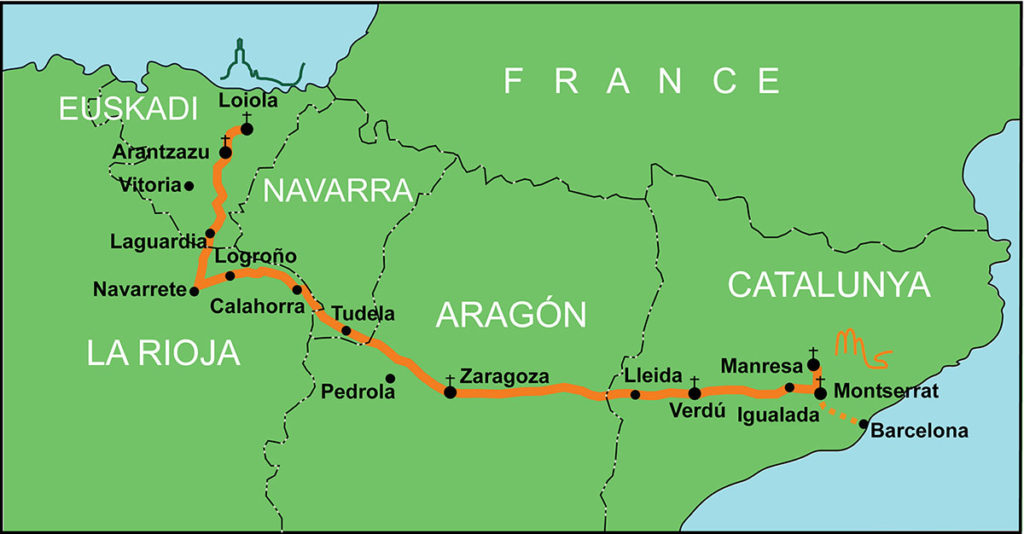2 Nov 2019
Mons Gerard Burns

It’s the biggest tourist attraction in Spain – the Basilica of Sagrada Familia (the Holy Family) in Barcelona. A fascinating place. Arriving, you find the crowds gazing upward, mouths agape, scanning the soaring, unusual spires and the stunning exterior decoration. Those who have some physics or building knowledge are amazed at the extraordinary architecture. If you are a scripture scholar, theologian or liturgist, the church is a feast.
Gaudi, the architect, was a Catalan nationalist who wanted to promote the place of the family in the midst of the heavily industrialised Barcelona of the late 19th and early 20th centuries. Construction began in 1883. Gaudi’s project may seem a backward-looking, romanticist project in the midst of the ‘modernity’ of factories, radical politics and ‘progress’, but his aim to celebrate the unity of prayer, scripture and creation seems more relevant than ever.
Unexpectedly this church at the end of my walking pilgrimage was a perfect completion to the trek. Through June 2019 I walked the camino Ignaciano in northern Spain ‒ a different ‘way’ (road) from the ones to Santiago de Compostela, acclaimed resting place of Santiago (St James) Apostle. The walk was a wonderful experience of prayer, community and creation. While not comparable to the wonders of nature, Sagrada Familia basilica summed it up.
Walking to Santiago is very popular ‒ over 250,000 walkers a year. However, I was looking for something quieter, giving plenty of time for prayer, solitude. Rather than going westward to Compostela I went east, towards Barcelona. The camino Ignaciano retraces a 1522 journey made by Ignatius of Loyola, from his Basque hometown to a small town called Manresa, near Barcelona.
Ignatius was in his ‘conversion process’ on his journey. As a vain soldier seeking a notable future among Spain’s court nobility, Ignatius’ dream was shattered when his leg was broken in battle. Enduring a lengthy and painful recovery at home, Ignatius began to read the Bible and the lives of the saints and to re-think his life.
Finding himself more interiorly nourished by these books than by the cheap novels he also read, Ignatius decided to live a saint’s life, starting with a pilgrimage to Jerusalem. He set off from his home towards Barcelona to sail for Rome and then to the Holy Land. The 600kms to Barcelona took longer than planned.
This was because he ended up staying 11 months in Manresa [capital of Comarca of Bages, in the geographic centre of Catalonia]. There he deepened his experiences of prayer, sought counsel from local spiritual guides and eventually moderated his excessive penances. The time become foundational for his famous Spiritual Exercises and rules for discernment.
My own walk had modest hopes – retreat, pondering a new stage of life, a physical test. The walk is only 10 years old so the support systems (lodgings, signage) are not as established as on the ways to Compostela, and there are fewer companions. On the plus side I could speak Spanish and interact easily with the ‘locals’. I would spend the first couple of hours each day in prayer using the framework of the 30-day Spiritual Exercises.

The camino is life
‘The camino is life’ is a common phrase meaning the goals, events and struggles of the camino reflect what happens in life. I found it to be true except that daily rhythm of 6 to 7 hours walking ‒ wake-walk-eat-find lodging-do laundry-sleep ‒ simplifies life wonderfully for someone accustomed to bustling, urban life. There is time to notice the skies, horizon, birds, insects, fields, the urban areas. And to appreciate the people you meet on the way.
I was solo for the first 10 of 27 days, meeting only one or two other pilgrims. However, I did not feel alone and at the lodging places was able to have some wonderful conversations with locals in mostly small, rural towns. When I did meet two other Dutch walkers it was good to have someone to share the journey with. They were doing the camino for the physical exercise; the fact that they were non-believers of a Protestant heritage made it more interesting.
I would walk on my own to pray for 2 to 3 hours and then we would walk the last section and find accommodation together. Jan and Walter gave me some interesting insights into myself and questions about my faith. It was not always possible to get to Mass each day but once when I came back from an evening Mass after also attending Mass the previous day, Jan asked me: You went again?! Has the story changed, is there a new episode? We laughed!
Jan was mystified that I should want to go back to do the same again. I realised what I valued: time for communal prayer; the faith example of others; the ever-new salvation-story of Jesus Christ, a key part of my pilgrimage. At one Mass I was moved to tears by the songs in Spanish I knew so well from my days in Latin America.
The kindness of my two-fellow pilgrims saw me through times of difficulty ‒ losing my cash card, managing a troublesome blister. We spent two days exploring the different aspects of Manresa and Ignatius’ time there. Ignatius stopped at Manresa to reflect on his three days at nearby Montserrat mountain and its Benedictine monastery, symbols of Catalonia.
Sagrada Familia has a similar silhouette to craggy Montserrat – an urban version of the mountain. The church brings together prayer, human community, all creation. The columns inside represent and are modelled on trees; the light through the roof is filtered like light through leaves. We stand amidst the rest of creation to give praise to God.
There are two completed entrance façades for the basilica. The nativity of Jesus/creation façade is covered with birds, animals, trees, insects, leaves and the Christmas story. The passion/death of Jesus façade enables us to enter through that ‘way’. The unfinished main entrance is the resurrection façade, a processional entrance through doors emblazoned with the words of the Our Father and the Creed (symbols of the Church’s faith). We come to Christ through the Church community processing, walking, on pilgrimage with Jesus towards the altar/sanctuary area. We are one family of creation en camino to God’s sanctuary.
Review of End of Life Choice Act: submissions now open
General
Published on 31st Aug, 2024
The first review, overseen by the Ministry of Health, is currently taking place [..]
Sisters conserve rare flag
General
Published on 31st Aug, 2024
A rare military flag has received much needed conservation work from the Carmelite Sisters [..]
Letter from Archbishop Paul Martin
General
Published on 5th Jun, 2024
A Vatican-led review of an abuse complaint against Cardinal John Dew dating to the 1970s has conclud [..]
'No Faith in Fossil Fuels' Climate Action Week
General
Published on 22nd Apr, 2024
We invite you to participate in No Faith in Fossil Fuels Climate Action Week from 3 May to 12 May [..]
May 2024 Funding Round | Catholic Charities Foundation
General
Published on 1st Mar, 2024
Applications for the May 2024 Catholic Charities funding round are now open [..]
